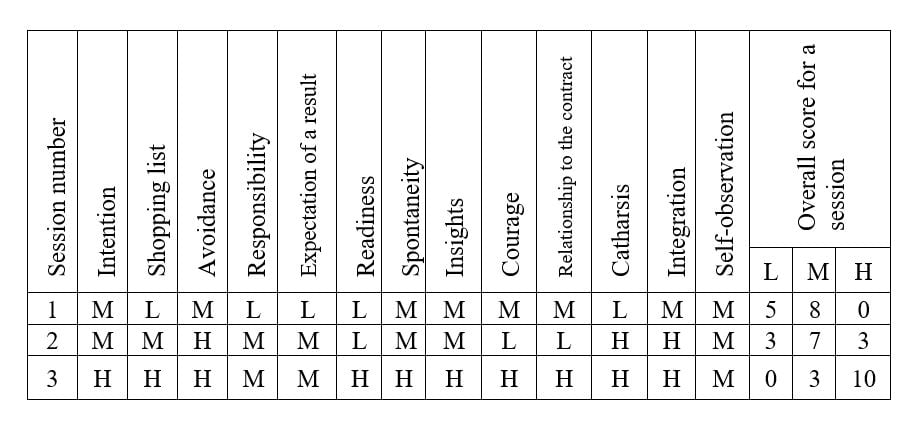by Peter Gadjev
 Abstract
Abstract
In this study the author presents the importance of the level of the client’s involvement in the therapeutic process. He defines indicators for measuring the three levels of involvement: low, medium and high. He briefly describes the results of the study and then presents factors on the part of the client and approaches on the part of the therapist, through which the level of involvement is influenced.
In sessions with a higher degree of client involvement, they report more successful results. Through the therapist’s ability to maintain a good level of involvement, the client increases their resources for a more successful therapeutic process.
During my studies at the Institute of Regression Therapy in Sofia under the guidance of Mrs. Silvia Petkova, I noticed that empathy and engagement appear to be of great importance for improving the quality of the therapy.
Definition of Concepts
Empathy means compassion, sympathy, and emotional intelligence. Engagement means presence, body awareness, responsibility for the process. The meanings of the two concepts could be both complementary and mixed. To facilitate this study, I have combined their meanings into one general concept—Involvement.
The aim of this study was to examine the impact of the level of client involvement in regression therapy.
Study Process
Steps:
To explore the significance of involvement levels, the following steps are implemented in this study:
- I establish indicators for measuring the levels of involvement.
- I observe the changes in the levels of involvement, both between the stages in the session as well as between the sessions themselves.
- I study the impact of the level changes on the quality of the session and the therapy.
- I keep track of reasons and approaches that increase the level of involvement.
I define three levels of involvement: low, medium and high. For each of the levels I describe the respective indicators and their criteria for measuring the level of involvement. The indicators are divided into three groups according to their position in the macrostructure of the session: before regression, during regression and after regression.
Indicators and their criteria
The criteria for the respective levels are marked with the symbols L (Low), M (Medium) and H (High). The criteria are defined as an action of the client.
Before regression:
Intention: Client’s actions for working on himself/herself.
L: Remains only with desire, without intention to work.
M: There is an intention, and an energy for work is detected.
H: There is an intention especially with self-respect.
- Shopping list: Client’s independence when announcing a topic for the session.
L: He/she cannot decide it alone; he/she relies on the therapist.
M: He/she is able to announce it almost by himself/herself alone, with certain help from the therapist.
H: He/she states by himself/herself a clear, well-formulated topic.
- Avoidance: Client’s use of someone else’s opinion of himself/herself, professional terminology, metaphysical concepts.
L: He/she hides behind other people’s perceptions or judgments, subconsciously gives up implementing a self-observation.
M: He/she does not use other people’s opinions, speaks on his/her behalf.
H: He/she speaks in his/her own words. Allows to be seen without masks.
- Responsibility: The degree to which clients take personal responsibility for the session and the process as well as the extent to which they leave it to the therapist.
L: The client relies almost or entirely on the therapist.
M: The client accepts his/her responsibility while relying on the support of the therapist.
H: The client is aware of his/her responsibility and explores his/her resources for work.
- Expectation of a result: To what extent does the client expect to have a resolved case “by law” ready after the session? How much does he rely on his own (personal) work?
L: He/she expects the session to work without his/her own efforts like a pharmaceutical pill.
M: He/she has no high expectations; increased curiosity about “homework”.
H: He/she is without expectations, relies on himself/herself and the process.
During regression:
- Readiness: To what extent is he/she determined to go through an “experience again”?
L: He/she lacks readiness; there is a scepticism, sometimes refusal.
M: There is a readiness, entering in a trance, and an emotional connection with “experiencing again”.
H: He/she easily enters the experience, seeks it, and explores it.
- Spontaneity: Through the spontaneity of the answers, I measure to what extent the client has devoted himself/herself to “there and then”.
L: Delayed reactions, premeditated answers, hidden emotions.
M: The answers come spontaneously, in time, emotions are shown.
H: Spontaneity, completeness. The client “answers” before the question.
- Insights: How the client answers insight-oriented questions.
L: There are no penetrations, or they are “sucked out” by the therapist.
M: There are certain insights, the client is resourceful enough.
H: Penetrations come easily one after another.
- Courage: The client’s desire to face a painful, vague or frightening experience.
L: The client runs away from the experience (story) with disrespect, distrust, unfounded fear.
M: The client goes through difficult moments. He/she trusts. He/she relies on the therapist to support and “pull him/her out” at the right time.
H: The client passes boldly with presence and awareness through difficult moments.
- Relationship to the contract: The client’s ability to relate the findings and understandings of the session to the contract.
L: He/she does not succeed.
M: He/she succeeds with the help of the therapist.
H: He/she succeeds by himself/herself alone and makes a connection even without being asked.
After regression:
- Catharsis: Does it lead to emotional and / or mental catharsis?
L: The client avoided or did not reached it.
M: He/she reached it with the help of the therapist.
H: He/she independently reached a strong catharsis, associated with insights.
- Integration: How the client communicates with the subject of integration, and how he/she rejects or accepts the integration.
L: He/she faces difficulties to communicate. He/she does not measure the impact / risk of integrating with previous life “talents”.
M: He/she communicates with the subject and integrates with him. Understands and appreciates the importance of “talents”.
H: Accepting the integration, he/she explores how it affects him/her. He/she wisely makes a decision on accepting or rejecting “talents.”
- Self-observation: The client’s reflection on changes and his/her actions and thoughts after the end of the session.
L: The client does not notice the changes and does not do “homework”.
M: The client observes himself/herself. He/she is interested in the session’s effect on him/her.
H: The client discusses issues and situations that have appeared between the sessions. He/she looks for other topics to work on and discusses the resources from the sessions.
For each indicator in the session, I assess the client’s level of involvement. I make a map with the assessments of those indicators. I calculate the sum for each of the levels in three columns. I receive sums for low, medium and high level. Through these sums, I provisionally assess the overall score for a session.
Example of a map of metrics and session levels for a client.
For each stage of the session, I mark the level of involvement for the respective indicators and compare the success regarding the indicator (and the stage as a whole) with those of the other sessions of the client. I compare the impact on the quality of work at the general level of one session both for this session itself and for the other sessions of the client. I study the reasons for the change, the result from the therapy, and what could be implemented to further increase the level of involvement.
 The study was conducted with ten volunteers. Some of the volunteers are my colleagues from the Institute, while others have no experience in regression therapy. My aim was to check if the experience in regression affects the level of involvement.
The study was conducted with ten volunteers. Some of the volunteers are my colleagues from the Institute, while others have no experience in regression therapy. My aim was to check if the experience in regression affects the level of involvement.
Results
- There is no session with a constant level of involvement. Particular indicator could have different levels in different sessions for the client. There is no client who remains with a constant level during all his sessions.
- For 70% of clients, the level of involvement increases with each subsequent session. In 20% of them, no change is observed, and in the rest 10% the level decreases.
- Interestingly, clients who have been married or have lived with partners show a higher degree of empathy and commitment than those who are single.
- No changes in the level of empathy and involvement were found in the different stages of the macrostructure within the sessions.
- When there is a medium and / or high level of involvement, the individual stages in the sessions are of higher quality. These sessions lead to stronger insights and catharsis. After such sessions, the volunteers report more successful results.
Factors influencing the change in the level of involvment
- The deteriorating condition of the clients and / or the therapist (fatigue, presence, mood, etc.) affects the level of involvement.
- Clients with experience in regression therapy and those with experience in personal growth groups show a higher level of involvement. Usually, the first sessions are of a lower level and gradually this level grows along with the gaining of experience. The “experienced” client uses his/her energy more successfully when working on himself/herself.
- The square of trust (confidence in the therapist and self-confidence of the client, self-confidence of the therapist and confidence in the client) releases the mental energy of clients to meet and experience painful and difficult situations, which respectively increases the level of involvement.
- There is a difference in the mental and intellectual catharsis. Mental, long analyses suck out the energy of the session and reduce the possibility of a higher level of involvement. At the same time, emotional catharsis charges and increases the level of involvement.
- Resistance to intense experiences could be manifested both mentally (consciously) and physically (subconsciously) by the clients. When facing such strong experiences without readiness, clients show physical resistance. This resistance leads to difficulties; it might even suspend the whole session.
- Dynamic equilibrium: a method for increasing the level of involvement – balance between three interconnected components:
-
- Intention to work: the desire of the clients to actively solve a problem.
- Readiness for the moment: the ability of the clients to cope with strong emotional experiences, difficult facts and thoughts at a given moment.
- Level of presence: The clients’ elliptical consciousness of there-and-then and here-and-now.
The connection of the Dynamic Equilibrium with the level of involvement is direct and mediated. The first two components coincide with the first and sixth indicators for determining the level of involvement – direct connection. The third component, in my opinion, is mandatory in personal therapies. The indirect connection is the practical possibility to influence the level of involvement through the method.
The balance is lost both in case of shortage and in excess of the intensity of the components. With a reduced intensity of “intention to work” the client loses enthusiasm to investigate the cases in depth, and he/she is almost locked in one place. When the intensity of “readiness for the moment” is reduced, protections of the client turn on and he/she can “skip” the painful experience and fail to get enough “capital” from it. When the “presence level” of the client becomes low, his/her attention and concentration are reduced, and the possibility of important first-person insights is omitted.

